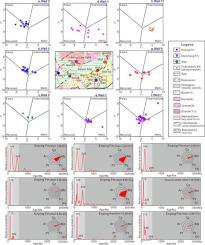当前位置:
X-MOL 学术
›
J. Asian Earth Sci.
›
论文详情
Our official English website, www.x-mol.net, welcomes your
feedback! (Note: you will need to create a separate account there.)
Using element geochemistry and detrital zircon geochronology to constrain provenance of the Eocene sediments in the deep-water area of the Pearl River Mouth Basin, South China Sea
Journal of Asian Earth Sciences ( IF 2.7 ) Pub Date : 2020-12-01 , DOI: 10.1016/j.jseaes.2020.104501 Yajun Li , Zhenglong Jiang , Hao Liu , Chuang Shi , Yuping Huang , He Zhang
Journal of Asian Earth Sciences ( IF 2.7 ) Pub Date : 2020-12-01 , DOI: 10.1016/j.jseaes.2020.104501 Yajun Li , Zhenglong Jiang , Hao Liu , Chuang Shi , Yuping Huang , He Zhang

|
Abstract As the largest sag in the Zhu II Depression within the Pearl River Mouth Basin, the Baiyun Sag (BYS) lies in an area of interaction among the Eurasian Plate, Pacific Plate, and Indian Plate. The BYS mainly experienced the Paleogene rift stage and Neogene–Quaternary post-rift stage. Thick syn-rift sediments in the BYS have recorded the nature of provenance and provide an excellent record of regional tectonic evolution prior to the opening of the South China Sea. In this study, elemental geochemical analysis combined with published zircon detrital U-Pb dating results are applied to better understand the provenance change and tectonic setting of the BYS during the Eocene. In this respect, the chondrite normalized REE patterns of Eocene samples from six wells are highly similar to upper continental crust (UCC) and post-Archean Australian shale (PAAS), particularly with respect to LREE enrichment, significantly negative Eu anomalies, and slight Ce anomalies. Geochemical results confirm that the BYS Eocene sediments were derived from a continental island arc to an active continental margin. In addition, the rock types of sources and the relatively narrow detrital zircon ages show that Mesozoic intermediate-felsic igneous and metamorphic rocks derived from local topographic highs contributed to infilling most of the BYS. Furthermore, the results show that the Panyu Low Uplift began to accept large sediments transported by the paleo-Pearl River from the South China coast during the active syn-rift stage, prior to the opening of the South China Sea.
中文翻译:

利用元素地球化学和碎屑锆石年代学约束南海珠江口盆地深水区始新世沉积物物源
摘要 白云凹陷(BYS)是珠江口盆地朱二坳陷中最大的凹陷,位于欧亚板块、太平洋板块和印度板块相互作用的区域。BYS 主要经历了古近系裂谷期和新近纪-第四纪后裂谷期。BYS 中厚的同裂谷沉积物记录了物源的性质,并为南海开放之前的区域构造演化提供了极好的记录。在这项研究中,元素地球化学分析结合已发表的锆石碎屑 U-Pb 定年结果,用于更好地了解始新世 BYS 的物源变化和构造环境。在这方面,来自六口井的始新世样品的球粒陨石归一化 REE 模式与上大陆地壳 (UCC) 和后太古代澳大利亚页岩 (PAAS) 高度相似,特别是在轻稀土富集、显着的负 Eu 异常和轻微的 Ce 异常方面。地球化学结果证实,BYS始新世沉积物来自大陆岛弧至活动大陆边缘。此外,源岩类型和相对较窄的碎屑锆石年龄表明,来自当地地形高地的中生代中长英质火成岩和变质岩有助于填充大部分BYS。此外,结果表明,番禺低隆在活动同裂谷期开始接受古珠江从华南沿岸运来的大型沉积物,
更新日期:2020-12-01
中文翻译:

利用元素地球化学和碎屑锆石年代学约束南海珠江口盆地深水区始新世沉积物物源
摘要 白云凹陷(BYS)是珠江口盆地朱二坳陷中最大的凹陷,位于欧亚板块、太平洋板块和印度板块相互作用的区域。BYS 主要经历了古近系裂谷期和新近纪-第四纪后裂谷期。BYS 中厚的同裂谷沉积物记录了物源的性质,并为南海开放之前的区域构造演化提供了极好的记录。在这项研究中,元素地球化学分析结合已发表的锆石碎屑 U-Pb 定年结果,用于更好地了解始新世 BYS 的物源变化和构造环境。在这方面,来自六口井的始新世样品的球粒陨石归一化 REE 模式与上大陆地壳 (UCC) 和后太古代澳大利亚页岩 (PAAS) 高度相似,特别是在轻稀土富集、显着的负 Eu 异常和轻微的 Ce 异常方面。地球化学结果证实,BYS始新世沉积物来自大陆岛弧至活动大陆边缘。此外,源岩类型和相对较窄的碎屑锆石年龄表明,来自当地地形高地的中生代中长英质火成岩和变质岩有助于填充大部分BYS。此外,结果表明,番禺低隆在活动同裂谷期开始接受古珠江从华南沿岸运来的大型沉积物,











































 京公网安备 11010802027423号
京公网安备 11010802027423号